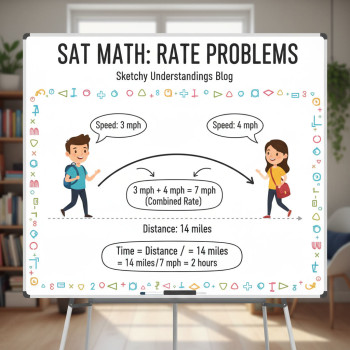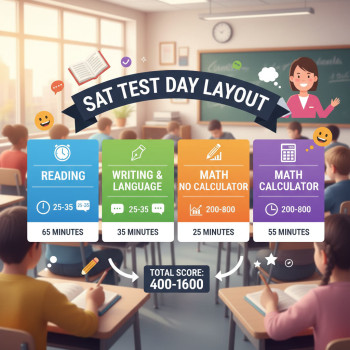Why Family Support Matters More Than You Might Think
The SAT can feel like a distant, looming checkpoint—part exam, part rites of passage. For many students, confidence isn’t just about how many practice tests they’ve taken or which strategies they’ve mastered; it’s about the emotional ecosystem they return to after a long day of homework and practice sessions. Family support—quiet, practical, and encouraging—can be the difference between a student who treats the SAT like an insurmountable wall and one who sees it as a series of manageable steps.
Confidence is contagious
Think about it: when a student hears phrases like “I believe in you” or “you’re making progress” from the people who matter most, those words land differently than the same praise from a stranger or a tutor. Family members who celebrate small wins, normalize struggle, and model consistent habits create a feedback loop that helps students internalize confidence.
How Family Actions Translate to Higher SAT Confidence
Support takes many forms: practical, emotional, and logistical. Below are real-world ways families can boost a student’s SAT readiness and self-belief.
1. Creating a Predictable Study Environment
Consistency reduces anxiety. A predictable study environment signals ‘‘this is what we do’’ and makes practice feel routine instead of monumental. Families can help by:
- Setting regular, interruption-free study blocks—short and focused beats marathon sessions.
- Providing a clutter-free workspace with good lighting, comfortable seating, and minimal distractions.
- Helping establish a daily rhythm: wake, study, break, recharge—repeat.
2. Normalizing Mistakes and Celebrating Growth
When parents and siblings treat mistakes as data—not judgment—they teach resilience. Statements like “You didn’t get this one right—what can we learn?” change the internal narrative from “I failed” to “I’m learning.”
3. Practical Support—Logistics That Matter
Logistics are surprisingly impactful. Getting a student to the test center rested, on time, and with the correct materials is a family win. Practical acts that reduce test-day friction bolster confidence more than a last-minute cram session.
Real Examples: Small Acts, Big Results
Here are three short, realistic vignettes that show how small family behaviors help students feel ready.
Example 1: The Daily Check-In
Every evening, Maya’s mom asks two questions: “What did you try today that was hard?” and “What went well?” This routine helps Maya reframe struggles as progress and reduces the all-or-nothing pressure that can paralyze preparation.
Example 2: The Quiet Weekend
When Jamal had a full practice test scheduled on Saturday, his family rearranged plans so mornings were quiet and tech-free. The simple shift allowed him to simulate test conditions and return from the practice test with clear takeaways—rather than being emotionally drained from competing household activity.
Example 3: The Celebration Jar
A family filled a mason jar with notes each time their student improved on a timed section or solved a problem type previously avoided. On tougher evenings the jar became a visual reminder of progress—evidence that confidence was being built step by step.
What Research and Experience Tell Us: Confidence Boosters that Work
While this article is conversational, it draws on common best practices observed by educators: structure, affirmation, and modeling. Families that combine these three elements tend to raise both competence and confidence. Below is a compact table showing how specific family behaviors map to student outcomes.
| Family Behavior | Student Outcome | Why It Helps |
|---|---|---|
| Regular quiet study blocks | Improved focus and time management | Creates routine, reduces decision fatigue |
| Affirmation after small wins | Growth mindset, lower test anxiety | Shifts focus to progress rather than perfection |
| Assistance with logistics | Less test-day stress | Removes friction that can derail performance |
| Encouraging balanced routines | Better sleep, nutrition, and energy | Improves cognitive performance and mood |
Practical Tips for Families: What to Do and What to Avoid
Here’s a practical playbook. These strategies are small, doable, and designed to fit into busy family lives.
Do: Create Micro-Routines
- Set 25–50 minute study blocks with 10–15 minute breaks (Pomodoro-style).
- Make a quick checklist for test-day items (admissions ticket, ID, water, snack, charger) and review it together.
Do: Offer Emotional Scaffolding
- Ask reflective questions: “Which concept felt most unfamiliar today?”
- Encourage realistic goal-setting: “Let’s focus on improving this one question type this week.”
Don’t: Turn Score Into a Single-Measure Conversation
Reducing a student to a single number places undue pressure on them and on family relationships. Instead, talk about skills, strategies, and long-term plans.
Don’t: Micromanage Every Minute
Over-scheduling can backfire. Provide structure, but leave room for autonomy—students who have some control over their study plan develop better long-term motivation.
How to Balance Support and Independence
Striking the right balance between supporting and stepping back is an art. Teenagers need the chance to fail safely so they can build self-efficacy. Here are practical ways to maintain that balance:
- Co-create the plan: Ask the student how much help they want and where.
- Enable decision-making: Let them choose which practice tests to take and when.
- Set checkpoints: Weekly reviews with neutral questions can keep things on track without daily oversight.
Incorporating Professional Help: When to Bring in a Tutor
Sometimes family support alone isn’t enough—especially when a student has persistent content gaps or struggles with test-taking strategies. That’s where a targeted tutoring approach complements family efforts. Good tutoring does not replace family support; it amplifies it. Tutors can provide:
- Individualized content instruction for weak areas
- Structured practice and feedback loops
- Motivation and external accountability
For families looking to pair at-home support with expert guidance, Sparkl’s personalized tutoring offers 1-on-1 instruction, tailored study plans, and AI-driven insights that help parents and students track progress together. When tutors and families coordinate, students benefit from both emotional stability and pedagogical expertise.
Study Plan Example: A Family-Friendly 8-Week Roadmap
This sample plan is intentionally flexible. It assumes 6–10 hours per week of focused SAT preparation and includes family touchpoints that build confidence without overwhelming the student.
| Week | Focus | Student Tasks | Family Role |
|---|---|---|---|
| 1 | Baseline & Goal-Setting | Take diagnostic test; identify weak areas | Discuss goals; create quiet study schedule |
| 2–3 | Foundational Skills | Work on core algebra, grammar rules, reading strategies | Provide time and tech-free mornings for practice |
| 4 | Timed Practice & Strategy | Take a full timed practice test; review mistakes | Simulate test-day environment; celebrate effort |
| 5–6 | Targeted Drills | Focus on recurring error types; refine timing | Encourage short study sprints; assist with logistics |
| 7 | Full Practice & Fine-Tuning | Two full practice tests; review strategy | Help with rest, snacks, and positive pep talk |
| 8 | Test Week | Light review, sleep, and mental prep | Reduce pressure, ensure restful nights, confirm logistics |
Conversation Starters for Families
Not sure how to bring up SAT prep without sounding preachy? Try these conversation starters that keep the tone supportive and collaborative:
- “What was one question today that made you think hard? Tell me about it.”
- “Which hour of the day did you feel most productive? Should we try to make that your study hour?”
- “If you could spend one week focusing on any single skill, which would you choose?”
Listening Beats Lecturing
Often the single most useful thing a family member can do is listen. When students explain a problem aloud, they clarify their own understanding—and families discover where help is actually needed.
Addressing Common Family Concerns
Families often worry about time, cost, and emotional fallout. Here’s a quick guide to common anxieties and practical solutions.
Concern: “We don’t have time for extra study.”
Solution: Emphasize quality over quantity. Two focused 45-minute sessions per day beat a single distracted three-hour period. Micro-habits added consistently compound over weeks.
Concern: “Tutoring is expensive.”
Solution: Targeted tutoring—focusing on weak areas or strategy—can be more cost-effective than generic packages. Some tutoring options, like Sparkl’s personalized approach, offer flexible plans and measurable progress tracking so families can see value before committing long-term.
Concern: “What if my child loses motivation?”
Solution: Keep preparation social and goal-oriented. Short-term incentives (a family movie night after a practice test) or visual trackers of progress can help. Encourage autonomy by letting the student set small weekly goals.
Measuring Success: Beyond the Score
Scores matter, but they aren’t the only way to measure growth. Confidence shows up in many forms: improved sleep before tests, fewer moments of panic during practice, increased willingness to tackle harder question types, and a general sense of calm on test day.
- Behavioral signs: fewer procrastination episodes, more consistent study habits.
- Emotional signs: reduced anxiety, greater resilience after setbacks.
- Skill-based signs: faster pacing, fewer careless errors, deeper comprehension.
Putting It All Together: A Family Action Plan
Here’s a short, three-step action plan families can implement this week to help boost SAT confidence immediately.
- Establish one predictable study block each weekday and one full practice test on a weekend.
- Start a progress ritual: five minutes after each study block where the student writes one success and one next-step.
- Schedule a weekly 20-minute family check-in—nonjudgmental, listening-focused, and solution-oriented.
The Emotional Bottom Line
Students prepare for the SAT in a thousand small moments: the choice to sit down at a desk, the decision to try another practice problem, the moment of pushing through discouragement. Families who show up consistently—through structure, encouragement, and smart logistics—help convert those small moments into lasting confidence. That quiet reliability signals to students that their effort matters and that they are not alone in pursuit of their goals.
How Professional Tutoring and Family Support Create a Powerful Duo
When family support and targeted tutoring work together, each amplifies the other. Tutors bring expertise, structured practice, and objective progress measurement. Families bring emotional safety, routine, and real-world logistics. Programs like Sparkl’s personalized tutoring can fit naturally into this ecosystem by offering 1-on-1 guidance, tailored study plans, and AI-driven insights that help families track what’s improving and where to focus next. The best outcomes come when tutoring is framed as a team effort—students learn new skills with an expert coach while families provide the steady foundation that makes practice possible.
Final Thoughts: Confidence Is Built, Not Given
Confidence isn’t an innate trait reserved for a lucky few. It’s an accumulation of daily choices, steady support, and the willingness to learn from mistakes. Families are uniquely positioned to create the conditions where confidence can grow: steady routines, meaningful reinforcement, and a steady hand on test day. Combined with targeted tutoring when needed, that family foundation doesn’t just improve SAT performance—it prepares students for the next stage of academic life with resilience and self-trust.
A Closing Note to Families
If you’re feeling uncertain about how to help, start with what you can control: time, calm, and listening. Those three things are often the most powerful study aids of all. And remember—every small supportive act contributes to a student’s sense of preparedness. The SAT is a moment in time, but the confidence you help build lasts much longer.
If you want, I can help you customize an 8-week plan tailored to your student’s strengths and schedule, and suggest targeted conversation starters and routines specific to their personality. Together, families and focused tutoring make confidence—and better scores—possible.
















No Comments
Leave a comment Cancel